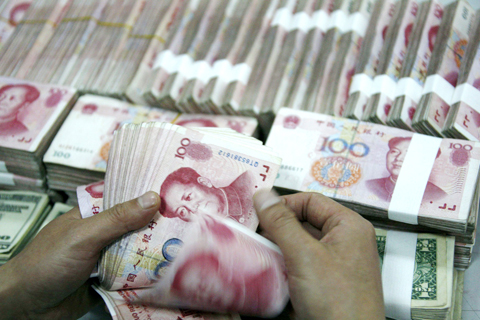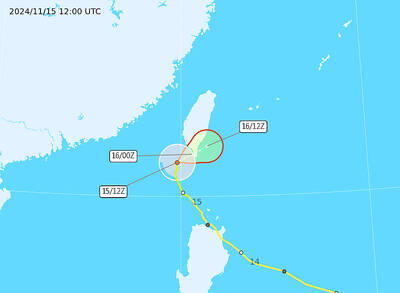The IMF said China should let the yuan gain to cool growth, while Japan must be prepared to widen its stimulus measures as Asia’s two biggest economies diverge.
Japan, with its “tentative” economic recovery, is an exception in a region that’s leading the global rebound, the IMF said in its semiannual “World Economic Outlook” report on Wednesday.
The Washington-based lender raised its projections for growth in Asia’s economies for this and next year. The IMF also raised its forecast for global growth this year led by China and cautioned that a failure of nations to contain soaring public debt might have “severe” consequences for the world economy.

PHOTO: REUTERS
Asia’s strengthening expansion, fueled by consumer spending and investment in China and India, means policymakers in several countries should embrace stronger exchange rates, the fund said.
The Group of 20 emerging and developed nations, whose finance chiefs meet today in Washington, should discuss coordinating policies to strengthen the global recovery, the IMF said.
“Currencies of a number of emerging Asian economies remain undervalued, substantially in the case of the renminbi [yuan],” it sai in the report.
It’s “essential” for China to address excess demand pressures by “reining in credit growth and allowing exchange rate appreciation,” the fund said.
The IMF’s comments reinforce calls from economic leaders from the US to India, Brazil and Europe for China to allow the yuan to rise. US lawmakers have proposed restrictions on Chinese imports to counter what they call the unfair export subsidy of an undervalued yuan.
China’s growth will accelerate to 10 percent this year from 8.7 percent last year, the IMF predicted, and raised its projection for next year to 9.9 percent from 9.7 percent previously.
India is expected to expand 8.8 percent this year and 8.4 percent next, compared with its estimates in January of 7.7 percent and 7.8 percent.
Japan, which is projected to be surpassed by China as the world’s second-biggest economy this year, will expand 1.9 percent this year and 2 percent next year after a 5.2 percent contraction last year, the report said.
“For Japan, with the reemergence of deflation, the current accommodative monetary policy stance remains appropriate, but additional easing measures may be necessary if deflation persists,” the IMF said.
The Bank of Japan last month doubled the size of a special three-month program providing loans to banks, to ¥20 trillion (US$214 billion).
By contrast, central banks in India, Malaysia and Vietnam have started raising interest rates.
“Given the region’s strong recovery, planning the speed and sequencing of the exit from stimulative macroeconomic policies must become a policy priority,” the IMF said. “In China, the withdrawal of the exceptional monetary stimulus introduced in 2009 will also minimize the risks from excessively easy credit conditions.”
Other priorities for officials in Asia include preventing the development of “speculative booms” as the region’s growth outperformance attracts a surge of capital from abroad, the IMF said.
The fund projected that the global economy would expand 4.2 percent thsi year, the fastest pace since 2007, compared with a January forecast of 3.9 percent. It expects an expansion of 4.3 percent next year.
The US economy will expand 3.1 percent this year before slowing to 2.6 percent next year, the IMF said. In January the fund expected growth of 2.7 percent for this year in the world’s largest economy.
The euro area is likely to expand 1 percent this year, unchanged from the January projection, and 1.5 percent next year, the report said.
IMF chief economist Olivier Blanchard said the rebound was “firming up, but it is what we call a multi-speed recovery” with “very slowly decreasing unemployment.”

Tropical Storm Usagi strengthened to a typhoon yesterday morning and remains on track to brush past southeastern Taiwan from tomorrow to Sunday, the Central Weather Administration (CWA) said yesterday. As of 2pm yesterday, the storm was approximately 950km east-southeast of Oluanpi (鵝鑾鼻), Taiwan proper’s southernmost point, the CWA said. It is expected to enter the Bashi Channel and then turn north, moving into waters southeast of Taiwan, it said. The agency said it could issue a sea warning in the early hours of today and a land warning in the afternoon. As of 2pm yesterday, the storm was moving at

UPDATED FORECAST: The warning covered areas of Pingtung County and Hengchun Peninsula, while a sea warning covering the southern Taiwan Strait was amended The Central Weather Administration (CWA) at 5:30pm yesterday issued a land warning for Typhoon Usagi as the storm approached Taiwan from the south after passing over the Philippines. As of 5pm, Usagi was 420km south-southeast of Oluanpi (鵝鑾鼻), Taiwan proper’s southernmost tip, with an average radius of 150km, the CWA said. The land warning covered areas of Pingtung County and the Hengchun Peninsula (恆春), and came with an amended sea warning, updating a warning issued yesterday morning to cover the southern part of the Taiwan Strait. No local governments had announced any class or office closures as of press time last night. The typhoon

At least 35 people were killed and dozens more injured when a man plowed his car into pedestrians exercising around a sports center in the southern Chinese city of Zhuhai on Monday night. Footage showing bodies lying on the pavement appeared on social media in the hours after the crash, but had vanished by early Tuesday morning, and local police reported only “injuries.” It took officials nearly 24 hours to reveal that dozens had died — in one of the country’s deadliest incidents in years. China heavily monitors social media platforms, where it is common for words and topics deemed

Typhoon Usagi yesterday had weakened into a tropical storm, but a land warning issued by the Central Weather Administration (CWA) was still in effect in four areas in southern Taiwan. As of 5pm yesterday, Tropical Storm Usagi was over waters 120km south-southwest of Oluanpi (鵝鑾鼻), the southernmost tip of Taiwan proper, and was moving north at 9kph, CWA data showed. The storm was expected to veer northeast later yesterday. It had maximum sustained winds of 101kph, with gusts of up to 126kph, the data showed. The CWA urged residents of Kaohsiung, Pingtung County, Taitung County and the Hengchun Peninsula (恆春) to remain alert to